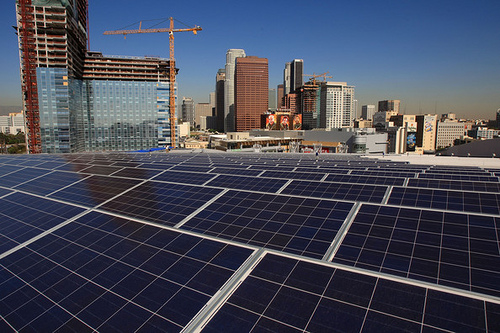An academic study jointly authored by UCLA and USC research teams finds that Los Angeles has a significant trained workforce ready to perform clean-energy solar jobs, but that city leaders have so far failed to enact policies that would take advantage of this resource and put city residents to work.
Further, the study finds that the areas in Los Angeles with the greatest potential for rooftop solar power – and thus the greatest capacity to support solar-related jobs – include many areas suffering from high unemployment and economic need.
“Unless civic leaders ramp up efforts to expand solar programs, the city and region face the prospect of being left behind,” states the report, Empowering LA’s Solar Workforce: New Policies that Deliver Investments and Jobs. “This report is, above all, a wake-up call to policymakers to make certain they are utilizing an important workforce segment – and creating policies that will put qualified people to work.”
The report, presented by the LABC Institute, will be formally released at the LA Business Council’s “Building LA’s Workforce” Summit at UCLA on Nov. 16. It will be discussed at the event by a panel that includes three leading mayoral candidates– City Council President Eric Garcetti, Controller Wendy Greuel and Councilwoman Jan Perry.
The study finds that, while California has set a goal of generating 33% of its energy from renewable energy by 2020, the region lacks sound policies to meet these goals and employ ready green-economy workers. In fact, the Los Angeles Department of Water and Power (LADWP) has one of the weakest solar track records among major California utilities, generating less than one sixth as much solar power per customer as the state leader, Southern California Edison.
The report urges officials to adopt a rooftop solar energy program known as a solar FiT (or feed-in tariff) that enables business owners and residents to install solar panels on their rooftops and sell surplus energy to the local utility. Such a program has been endorsed by a coalition of environmental groups, labor leaders, business organizations and other stakeholders.
The UCLA and USC research teams – led by J.R. DeShazo of the UCLA Luskin Center and Manuel Pastor of the USC Program for Environmental and Regional Equity – had previously established the need for a rooftop solar program in Los Angeles, and its potential to benefit low-income Angelenos. A robust program could create $2 billion in local investment and create 16,000 job-years with a minimal impact on ratepayers. Past studies are available at LABC’s website, www.labusinesscouncil.org/sustainability.
The region’s significant number of ready-to-work solar professionals is the result of plentiful local training programs, run by organizations as varied as Homeboy Industries, IBEW Local 11, and the Los Angeles Trade and Technical College. Roughly 2,200 people are trained each year in Los Angeles County alone for jobs in solar panel installation, design, sales and other areas. The study breaks new ground in examining these programs, and argues that city officials can enact policies to give these workers greater opportunity to find work – while growing an essential new industry.
“What’s so compelling about this research is that it matches the need for good, local jobs and the mandate for clean, renewable energy,” said Los Angeles Business Council President Mary Leslie, whose group has been pushing for a robust rooftop solar program ever since Mayor Villaraigosa called for it three years ago. “We were astonished to see how cleanly the job-creation potential, the social equity aspect and the environmental imperative go hand-in-hand.”
Through the use of advanced mapping techniques, USC researchers were able to determine the areas of greatest solar potential – primarily, those sections of Los Angeles with a high density of large rooftops, whether commercial, industrial or multifamily residential. Further, they were able to overlay those areas with those communities suffering from high unemployment and high poverty.
The result is a clear picture of which areas stand to gain the most from expanded solar development – and also those that have the greatest need. Solar “hotspots” exist in the San Fernando Valley, eastern Los Angeles, and areas west of downtown, including Hollywood. In many cases, solar training programs are located near these “hotspots” – and near areas of great need.
“Los Angeles has a unique confluence of characteristics: abundant sunshine, a trained workforce and tremendous economic need,” said USC’s Pastor. “The right policies will enable Los Angeles to be a leader in both solar energy and in putting people to work.”
The report also includes an analysis from UCLA that sheds light on the performance of California utilities in generating solar power under the California Solar Initiative, or SB 1. In addition to determining that LADWP lags far behind other local utilities in generating solar power, it finds that the city-owned utility also ranks nearly last in the cost per solar job created. Whereas Burbank could create one job-year at a cost of $36,000, LADWP’s cost was more than $129,000.
“These figures tell us that LADWP has not been as successful as other local utilities either in bringing solar to market or in its efficiency in doing so,” said UCLA’s DeShazo. “Looking forward, policy makers can take note of past performance as they weigh the proper steps moving ahead.”
The report advocates a solar FiT as part of a comprehensive approach to advancing solar development in Los Angeles. Unlike existing rooftop solar programs, the FiT is specifically designed to generate a net energy increase– not simply to offset the user’s needs.
“The solar FiT can create hundreds if not thousands of clean energy plants right here in Los Angeles,” said LABC Chairman Jacob Lipa. “By working in partnership with the private sector, the solar FiT enables a far greater reach than public sector programs alone. The benefits in jobs and economic impact are tremendous.”
The report calls for making use of federal and state subsidies to grow the emerging solar industry; channeling benefits to disadvantaged communities; engaging a multi-sector workforce development partnership; advocating for continued funding of green training programs; and more.
The UCLA/USC report closes with a clear sense of purpose:
“We have a ready market, and a ready set of policies. Generating solar jobs will require continued strong implementation of energy goals and incentivization of the local market. It will require that local utilities be made accountable for their current solar efforts by policymakers who can assess the job-creation impacts – and their costs – relative to desired outcomes. And it will require that equity and the environment come together in programs to connect disadvantaged workers with solar employment.”
To download the report, please click here. BD+C
Related Stories
| May 21, 2014
Architecture Billings Index in the negative for second consecutive month
The March ABI score was 49.6, up slightly from a mark of 48.8 in March, but still below the growth threshold of 50.
| May 20, 2014
Kinetic Architecture: New book explores innovations in active façades
The book, co-authored by Arup's Russell Fortmeyer, illustrates the various ways architects, consultants, and engineers approach energy and comfort by manipulating air, water, and light through the layers of passive and active building envelope systems.
| May 20, 2014
Gensler envisions 'law firm of the future' with pop-up office project
Called "The Legal Office of the Future," the pop-up demonstration project made its debut this week at the annual conference for the Association of Legal Administrators in Toronto.
| May 20, 2014
Using fire-rated glass in exterior applications
Fire-rated glazing and framing assemblies are just as beneficial on building exteriors as they are on the inside. But knowing how to select the correct fire-rated glass for exterior applications can be confusing. SPONSORED CONTENT
| May 20, 2014
World's best new skyscrapers: Renzo Piano's The Shard, China's 'doughnut hotel' voted to Emporis list
Eight other high-rise projects were named Emporis Skyscraper Award winners, including DC Tower 1 by Dominique Perrault Architecture and Tour Carpe Diem by Robert A.M. Stern.
| May 19, 2014
What can architects learn from nature’s 3.8 billion years of experience?
In a new report, HOK and Biomimicry 3.8 partnered to study how lessons from the temperate broadleaf forest biome, which houses many of the world’s largest population centers, can inform the design of the built environment.
| May 19, 2014
Why e-commerce won't kill 'bricks and mortar' retail sector
Despite emerging structural challenges and newly-announced store closings, such as those of Radio Shack and Office Depot, the U.S. retail sector has continued on its solid recovery.
| May 16, 2014
BoA, USGBC to offer $25,000 grants for green affordable housing projects
The Affordable Green Neighborhoods Grant Program will offer 14 grants to developers of affordable housing in North America who are committed to building sustainable communities through the LEED for Neighborhood Development program.
| May 16, 2014
HED expands leadership in San Diego
Neville Willsmore, Thomas Christian join leadership team for Harley Ellis Devereaux.
| May 16, 2014
Toyo Ito leads petition to scrap Zaha Hadid's 2020 Olympic Stadium project
Ito and other Japanese architects cite excessive costs, massive size, and the project's potentially negative impact on surrounding public spaces as reasons for nixing Hadid's plan.















